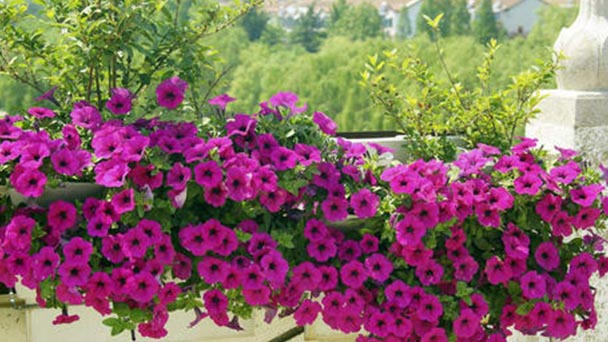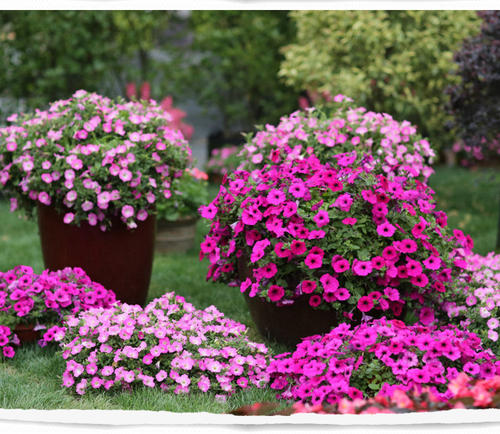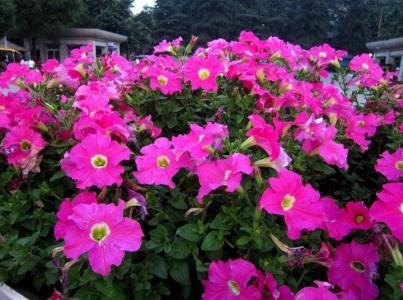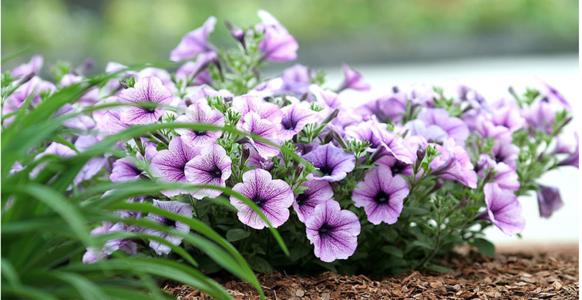Petunias Profile
Written by Maggie
Oct 28 2021

Petunias, scientific name Petunia × atkinsiana, is a perennial herb, often cultivated as a biennial, 20 -- 45 cm high; Stems are prostrate, covered with clingy pilose; Leaves are soft, ovate, entire, alternate, upper leaves opposite; Petunias is single, funnel-shaped, double globular, white, purple, or red with a fringe, very beautiful, April to frosting; The seeds are small.It is distributed in South America and is now popular in many countries.
Petunias Picture
Characteristics of Petunias
Petunias Appearance
Petunias is a member of the Solanaceae genus Elysium. Petunias is a perennial herb, which is often cultivated for one or two years. The plant height is 15 ~ 80cm, and there are caespitose and creeping types.
Petunias Leaf
Leaves of Petunias are elliptic or ovoid; After sowing, the flower can bloom in the same year, the flowering period is several months long, the corolla is trumpet-shaped; The flower shape has single valve, double valve, flap margin fold or irregular zigzag, etc.
Petunias Flower
The designs and colors of Petunias are red, white, pink, purple and various kinds of spots, reticulations, stripes and so on. Capsule, very small seeds, 1000 seeds weight about 0.1g.
Petunias blooms from April to May.
Habit of Petunias
Petunias likes a warm environment, but it also needs to keep the sun shining for 12 hours a day to brighten the flowers. Petunias likes wet environment but afraid of waterlogging, so to do a good job of drainage and waterlogging prevention. Petunias are more resistant to high temperature environments and afraid of frost, the temperature is higher than 35 degrees and can still grow, but below 4 degrees may be frostbite, so pay attention to keep warm in winter.

How to Grow & Care for Petunias
Petunias Soil Care
Petunias require slightly acidic, loose, fertile, well drained soil, basin soil can be generally used sandy loam and leaf rot soil half mixed preparation.
Petunias Fertilizer
Petunias has a long flowering period and needs constant nutritional supplements to bloom continuously. Therefore, thin liquid fertilizer is generally applied every 10 days or so during the growth period. More phosphate fertilizer should be applied during the gestation period to facilitate colorful flowers.
Petunias Watering
Watering should be appropriate at ordinary times to prevent too dry or too wet. Too dry plants are prone to wilting, too wet to rot root. Summer weather is hot, evaporation maximum, should be timely supplementary watering, keep basin soil moist but not water, rainy season needs timely drainage waterlogging prevention.
Petunias Temperature & Lighting Care
Petunias is a long-day plant, which requires strong light conditions for photosynthesis to proceed smoothly. Therefore, sufficient light should be given to both pot and ground plants. Sunshine is strong growth. If the light is insufficient, the branches and leaves of Petunias are easy to grow empty, and the flowering is less or the quality of the flowering is poor. If you can give more than 12 hours of light a day, and the night temperature is above 10℃, you can flower in four seasons.
Petunias Pruning
When the seedlings of Petunias grow to about 10 cm high to pick the heart, to promote the germination of lateral branches, then bloom more. If you do not need to keep seeds after each flower, you should cut off the residual flowers of Petunias in time, and cut short branches, but also continue to germinate lateral branches, constantly flowering.
More about how to care for Petunia.
How to Propagate Petunias
Petunias can be propagated by either sowing or cutting. Spring sowing and autumn sowing can be used. Because the seeds of Petunias are small, it is necessary to seed with fine soil after sowing, slightly suppressed after sowing, not covered with soil, sowing temperature of 20-24℃, 4-5 days can be germinated, after the emergence of 9-13℃, seedlings grow well. Seedlings of Petunias need to be transplanted once before they can be planted in the open field. Spring-sowing seedlings grow two true leaves after transplantation once, summer can be planted in the open or on the pot. Autumn seedlings must be transplanted, on the basin, turn over the basin 1 times, in the greenhouse or cold bed without heating, winter temperature should not be less than 10℃. Double petals and large flower varieties of Petunias are not easy to be strong or seedling is not easy to maintain the good traits of the mother plant, can be used for cutting propagation, early spring flowers or autumn to cut off the branches, promote Petunias heavy hair twigs, cut branches can be cuttings, inserted into the sand, at 20-23℃ under the condition of 2-3 weeks to take root, cutting seedlings can be not less than 10℃ in the greenhouse winter.
Petunias Flower Language
Petunias flower languages are peace of mind, concentric with each other, among which the white Petunias means existence, the purple Petunias means broken love, and the double Petunias means everlasting love. Most of the varieties of flower language are very beautiful, which has a certain relationship with its color, some varieties of color will be with stripes or stripes, so the meaning of a better future.

Read Next:
How to Care for Petunias
Top 10 Most Beautiful Roses in the World
Top 10 Most Beautiful Flowers in the World
26 Best Autumn Flowers to Plant for Fall Color in Garden
Latest Updated
- Benefits of Bugleweed - 7 Science-backed Health Benefits
- Bugleweed Dangers & Side Effects - Is It Poisonous?
- How to Plant Evergreen Trees - What You Should Know
- When to Plant Evergreens - Grow Guide for Evergreen Trees
- 12 Wonderful Evergreen Shrubs for Your Garden
- 12 Popular Evergreen Plants with Pictures for Beginners
- When And How To Prune A Lilac Bush Like a Pro
- How to Grow & Care for Lilac Vine (Hardenbergia Violacea)
- Japanese Lilac Tree (Syringa Reticulata) Care & Propagation Guide
- Shumard Oak Pros and Cons - What to Know
Popular Articles
- Winter maintenance of Antirrhinum Majus
- How to Grow Terminalia Mantaly Tree
- How to Grow and Care for Crossostephium Chinense
- How to grow Antirrhinum Majus in spring
- Peristeria Elata (Dove Orchid) Profile: Info & Care Guide
- Underwatered Snake Plant (Sansevieria Trifasciata) - Signs And How To Fix
- How to Care for Brazilian Jasmine Plant (Mandevilla Sanderi)
- How to Grow & Care for Graptopetalum Purple Delight in Summer
- Rosa Chinensis (China Rose): Plant Growing & Care Tips
- How to Care for Baby Sun Rose (Aptenia Cordifolia)
